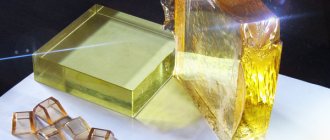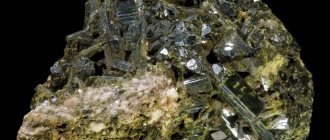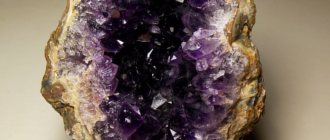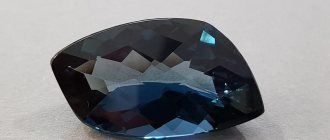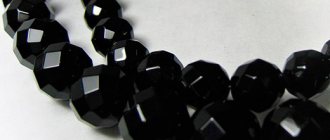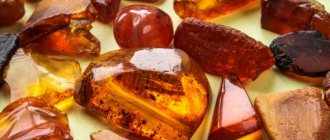- Which: Precious;
- Deposits: Worldwide, except Antarctica;
- Colors: From scarlet to yellow, green and transparent;
- Mohs hardness: 6.5-7.5;
- Transparency: Transparent or translucent;
- Density: 3.47-3.83 g/cm3;
- Formula: R2+3 R3+23;
- Suitable person according to zodiac sign: Everyone;
- How much does it cost: from 1000 rubles per carat.
Garnet stone has been known to people for a long time. Mystical and healing properties were attributed to this precious stone, and, of course, it was widely used in jewelry.
It is one of the twenty most expensive stones in the world and is rightfully considered one of the most beautiful minerals.
History of the origin of the stone
The garnet stone received its modern name in 1270. It was then that the famous alchemist Albert Magnus, describing this rare red mineral, gave it the name “granatus”. This word is related to the term “granules” and literally translated from Latin means “granular.”
Indeed, natural pomegranate occurs in nature in the form of small round granules. Moreover, the size of the unprocessed mineral does not exceed the grains of the tropical fruit of the same name.
In ancient times, each nation gave this gem its own name:
- “Chervets” or “lal” - in Rus'.
- “Bijazi” - in the Arab East (in Russia this word was gradually transformed into “bechet” and quickly took root among the people).
- The Greeks in ancient times called this gemstone “anthrax” - burning coal.
- And the ancient Roman name, also translated as “coal” - “carbuncle” - was used until the 19th century.
What colors of garnet are there?
The main physical properties of the stone include:
- noticeable shine, which can vary from unexpressed glass to mesmerizing diamond;
- transparency (also varying in degree: from completely translucent specimens to tightly filled with ruby languid color);
- the mineral density is about 4, and the Mohs hardness does not exceed 7.5;
- the ability to be magnetized and electrified (rub a garnet on a mohair sweater, and it will immediately begin to attract hairs);
- rich color range.
Each color has its own name: red - pyrope, cherry - almandines, green - uvarovites, brown or brown - andradites. There are other interesting shades, for example, grossular - light green or brown, similar to gooseberry. But the red or honey-yellow hue is called hessonite. There is even a rare black garnet in nature. Blue garnet is considered a nugget, of which there are several hundred in the world. This heavenly beauty gem was first found in the late 1990s in Madagascar.
Today we will definitely mention what color stones it is better to choose so that their chemical properties help your health and state of mind.
Description of pomegranate
Garnet is one of the most worthy rivals of ruby. They are similar both in appearance and in their physical properties (although ruby is a harder mineral). Externally, garnet looks like a transparent or translucent stone with a glassy shiny, very smooth surface.
Garnet patronizes travelers, warriors, lovers, women expecting a child, and people in difficult life situations.
Physico-chemical characteristics of garnet
Silicates with an island structure - garnets - combine six types of minerals: pyropes (magnesium-aluminum salt), almandines (aluminum-iron salt), spessartines (mangan-aluminum salt), uvarovites (calcium-chromium salt), grossulars (calcium-aluminum salt ), andradites (calcium-iron salt).
Natural garnets also contain inclusions of titanium and vanadium. — Advertising —
According to the color characteristics, there are various garnets, except blue ones. Pyropes are dark red, almandines are pink or cherry, uvarovites are bright green, pink, colorless, andradites are red-brown, brown.
The hardness of the crystals on the Mohs scale is 6.0-7.5. Specific gravity 3.2-4.3 g/cm3. They are transparent or opaque; as a rule, the brighter the color, the less transparent the sample. They have a glassy, resinous or diamond luster.
Colors and varieties
Most often, when talking about garnet, we mean the classic dark red or, in extreme cases, pink color of this mineral. However, these are far from the only varieties. The color of garnet stone can vary from scarlet to yellow, green and even transparent.
Pyrope
The most common red garnet. Its name comes from the Greek word “pyropos” - like fire. Magnesium and aluminum salts give the stone its peculiar shade.
Almandine
A mineral characterized by a high content of potassium and magnesium. Depending on their concentration, the color can vary from deep red to brown, purple and pink. It is to this variety that the “Bohemian” or “Czech” garnet belongs - a very expensive, almost transparent gem of a light pink hue.
In Rus', almandine, brought from the Arab East, was called “Syrian garnet.”
Grossular
Allumocalcium silicate, the color of which is given by iron ore salts. The very name of this stone comes from the Latin name for gooseberry, which speaks better than any words about the appearance of grossular: small round stones shine in all shades of green and yellow.
Grossular can be:
- light herbaceous;
- orange-yellow;
- dark brown;
- transparent;
- and even an extremely rare sea green color (in mineralogy it bears the name hydrogrossular);
Uvarovite
An extremely rare emerald green garnet found in only a few deposits in the world. It was first discovered in the Urals, in the Saranovsky mine, in 1832 and named after the Russian academician and minister of education, Sergei Uvarov. This stone is often called the “Ural emerald.”
Andradite
This mineral received its name in honor of its discoverer, Jose d'Andrada. In nature, this type of pomegranate has different shades - from yellow and greenish-marsh, to brown and even red. The most popular varieties of andradite are:
Melanitis
An incredibly rare black garnet, characterized by an opaque, matte structure. In fact, this color is a dull dark red, but due to the lack of shine, the stone absorbs almost the entire spectrum of the sun's color, which is why it appears charcoal dark.
Shorlomit
Another type of black garnet, rich in iron salts, thanks to which the edges of the stone have a bright shine with a metallic tint.
Demantoid
An extremely rare transparent gem, distinguished by its light green color. Its name means, literally translated, “like a diamond,” although in appearance it rather resembles an emerald. This mineral is often found in the decoration of Russian palaces of the 18th – 19th centuries.
Spessartine
For the first time, this stone began to be mined in the town of Spessarty, in Germany - this is where the official name of this garnet variety came from. The main colors are yellow, brown, and pink, although there are also examples of a red tint.
Hessonite
Or in other words “essonite”, “cinnamon stone” - garnet of all shades of brown. The most common shades found in nature are yellow, honey, orange, and purple. Occasionally, cinnamon-colored hessonites are found. This is one of the least hard types of pomegranate. Actually, the word “hesson” itself means “weak”, “lesser” in Latin.
Rhodolite
Some mineralologists classify it as a separate group, but in fact it is a hybrid of almandine and pyrope. The high iron content also determines the colors found in this mineral: red and pink in any shade.
Leucogranate
This is the general name for all minerals of this group, distinguished by their transparent color.
Application
The scope of application of pomegranate is extensive. Due to its ability to split into sharp crystals, raw garnet is used in the abrasive and construction industries (in the form of additives to cement mortar).
The natural mineral is successfully used as a replacement for expensive rubies and sapphires in instrument making, and is also used in ferromagnets due to its magnetic sensitivity and high conductivity.
In ancient times, ornamental garnet was used as a basis for cameos and figurines depicting gods. Then the mineral began to be processed in the form of cabochons, much later, transparent garnets of beautiful and rich colors began to be cut and actively used as jewelry. This stone gained particular popularity only in the 19th century.
Rhodolite, a type of garnet, is widely used in jewelry. High-quality crystals lend themselves well to cutting; after processing, such rhodolite most often acquires a round cut, as well as oval and stepped edges. Low quality stones are used as cabochons. Rhodolite is equally popular as jewelry among both men and women. Rhodolite most often has pink shades, and its price rarely exceeds 1,500 rubles, but gems with an alexandrite effect are valued even higher. Andratite is used no less often than rhodolite in jewelry. Due to the variety of varieties and shades, this type of pomegranate has gained great popularity. Of particular interest is the rare black andradite, which looks most elegant in silver. Descriptions of jewelry with it can be found in memoirs and novels of the 19th century; it was then that black stones became very popular, as mourning fashion was actively developing.
Garnet druses and brushes rarely find practical use; much more often the unprocessed gem in this form can be found in private collections or museums.
Chemical composition and physical properties
Garnets are silicates with a high content of magnesium, calcium and iron. Depending on the chemical composition, their individual types are classified as both precious and semi-precious, ornamental stones. The general formula of all these minerals looks like this: Mg+Fe+Mn+ +Ca+3Al2[SiO4]3.
At the same time, each subspecies of pomegranate has its own chemical composition. It is the concentration of certain elements that determine the shades of garnet, density and shine.
Despite the number of varieties of stone, its properties in all “varieties” remain approximately the same.
Garnet molecules have a cubic lattice and form either rhombododecahedrons (closed compounds of 12 faces) or tetrahoptrioctahedra (24 faces).
Scientists divide all pomegranates into two main subspecies:
- Pyralspite, which is dominated by iron, magnesium and manganese; form a 12-sided crystal lattice; This is exactly the structure of pyrope, spessarine and almadine.
- Ugrandites, with a high calcium content (as, for example, in uvarovites, grossulars and andradites). The molecules of these gems are formed into tetrahoptrioctahedra.
The hardness of these gemstones ranges on the ten-point Mohs scale from 6.5 (like hessonite) to 7.5 (like pyrite and almandine). Garnet can be easily polished with diamond, but if you run it across glass, it leaves a shallow scratch.
At the same time, it is quite fragile and easily breaks under a strong impact. So processing it is not such a simple matter.
The density of this mineral is low: on average from 3.47 to 3.83 g/cm3.
The surface of the garnet is smooth to the touch, glassy. But the edges of the break, on the contrary, are uneven and rough.
In nature, this gem is found in medium-sized druses. These stones are not large. The largest garnet, a fire pyrope the size of a pigeon's egg, was discovered in Germany and weighed 633 carats.
How is garnet formed?
Garnet crystals occur in igneous rocks - schists and gneisses. In the case of crystalline slate, garnet (and in this particular case, almandine) is the rock-forming mineral. Its companions are often micas, chlorite and disthene. In this case, the origin of the mineral is metamorphic.
The second option for the formation of these semi-precious gems is the contact process, otherwise called skarn. For the formation of such types of minerals as grossular and andradite, contact of the rock with limestone rocks, rhodolites, eclagites, etc. is necessary.
In skarns, garnet is accompanied by sulfites of iron, copper and lead, as well as salite, vesuvian, scheelite, etc. Garnets are often part of igneous rocks, such as peridotites and kimberlites, granite, and appear on the surface due to the activity of volcanoes.
Natural garnet is a very resistant material, therefore, when the rock weathers, this gem is not subject to destruction, but turns into placer.
Place of Birth
Garnets are mined all over the world. Their deposits are found on almost all continents, with the exception of Antarctica. Pomegranates are found in Russia, the USA, Germany, Mexico, Australia, Zambia, Brazil, India, Sri Lanka and some other countries.
In Russia, the largest deposits are located in Yakutia (very rare fiery red pyropes are mined there), on the Kola Peninsula, Chukotka and the Urals. It is the Ural mines that supply jewelers with a significant portion of green uvarovite.
In the USA, on the border of the states of Colorado, Utah, New Mexico and Arizona, one of the most amazing types of this gem is mined: “Ant”, or “Arizona” garnet.
These tiny stones, no more than one and a half carats, are brought to the surface by ants when building their “palaces”. The surprising thing is that, despite all the efforts, it was not possible to detect these bright red granules using the mine method.
Garnet deposits
The most famous garnet deposits are unique placers located in the mountains of the Central Bohemian region, as well as diamond-bearing kimberlite pipes in eastern and southern Africa. Complex deposits of garnets, diamonds and chrysolites were discovered in Yakutia. Certain varieties of pomegranate are also mined in Germany and other European countries.
Who is suitable according to their zodiac sign?
Despite the fact that the magical properties of this stone are in many ways universal, astrologers advise people, before buying jewelry with garnet, to check whether their patron constellation is combined with the magical properties of the “fire” stone.
For those who decide to purchase a garnet stone, their zodiac sign is very important:
- Aquarius: Pyrope and other varieties of red garnets are strictly contraindicated for people born during this period. But hessonite, grossular and uvarovite will give their owner success in matters of the heart, help to remain faithful in separation and strengthen the sense of trust in their “soul mate”.
- For Pisces, this stone is an excellent remedy that helps normalize blood pressure and avoid infections. True, they also cannot carry red grenades.
- Aries: pomegranate is useful for them as a means to cope with temper and avoid quarrels. It also helps in the fight against various phobias.
- Taurus should not buy garnet jewelry.
- Gemini needs to be careful with this stone: it not only gives self-confidence, but also gives rise to passions that are not easy for the ardent nature of Gemini to fight.
- Cancer. For them, pomegranates are contraindicated, with the only exceptions being green varieties.
- For Leos, pomegranate products are useless, although not dangerous.
- This gemstone will help Virgos find harmony and find their path in life.
- Libra: they sometimes need pomegranate as a way to calm their nerves and subdue their impulses.
- For Scorpios, this gem will help moderate their ambitions, achieve peace of mind, and help them reach agreement in love and friendship. At the same time, garnet will help this sign develop their leadership abilities.
- Sagittarius will feel a surge of strength from this gem - both mental and physical.
- Capricorns: pomegranate will help them gain self-confidence, give them strength and insight to make the right decision.
Garnet Fiery Passion
One of the most beautiful natural stones is garnet. Pomegranate “seeds” are distinguished by some particularly lively aura and energy. They are really unusually similar to pomegranate (fruit) seeds. By the way, the name of the stone is translated from the Latin “granatus” - “similar to grains.” This is exactly what the medieval alchemist Albert Magnus, famous in his time, first called it.
Garnet is a precious stone. Its cost can reach up to $10,000 per carat, depending on the size, shade and transparency of the stone.
An extravagant, very “tasty” stone with a rich, rich palette and an amazing glassy shine. Garnet has quite a variety of colors: in nature, red and dark red garnets are more common, and less common are orange, lilac, green, violet, and black.
Whatever the shade of garnet, this stone can almost always be recognized - it is so special. Pomegranate seeds have complex, fantastically beautiful shades. The charming shades of garnet are determined by the composition of this mineral. The stone gets its exquisite red hue due to its high iron content.
Garnet is the stone of mature and experienced
Garnet is considered the stone of lovers. To express your recognition and love, you can give any jewelry with garnet - earrings, rings, bracelets, beads, etc. Garnet is one of those rare stones that can and should be given as a gift. In the old days, it was believed that the magical properties of a pomegranate were greatly enhanced when it was inherited or given as a gift by a very close person. But stolen grenades, according to ancient legends, bring misfortune.
Garnet rings symbolize friendship, love and gratitude. Too young beauties are advised to be careful with this stone - garnet can cause strong passion and strong love feelings. We can say that this is the stone of mature and experienced women. Garnet is most suitable for passionate, ambitious ladies with strong spirit and character. The mineral lifts the mood, cheers the heart, gives cheerfulness and optimism. In ancient times, he was considered a healer of the heart and brain.
This beautiful mineral has many varieties, which are known to the world under their own individual names. Garnets with a bright red hue, according to modern classification, are called pyrope.
Common gem varieties of garnets include:
- almandine (magenta, violet),
- demantoid (green, golden-green),
- grossular (yellowish-greenish),
- uvarovite (emerald green),
- spessartine (orange),
- andradite (black, green, brown-red).
It is interesting to look at a garnet under different lighting - the color of the stone changes like a “chameleon”. The richest and brightest colors are revealed to the eye in sunlight. Under artificial lighting, the same stone will glow with a different shade. No less interesting, but different! Green garnet (demantoid), for example, in the evening under lamplight can be confused with yellow garnet (grossular).
In Russia, pomegranate has long been called “Venice”. Russian scientist Vladimir Dal in his “Explanatory Dictionary of the Living Great Russian Language” described garnet this way: “Venice is a fossil of honest stones, translucent, of the darkest red color.” In ancient times in Rus', a bright red garnet was called “carbuncle”, which means “coal”, as well as “worm-shaped yakhont” (“red yakhont”). Green varieties of garnet were often popularly called “olivines.”
People learned about pomegranate more than 3,000 years ago. In Antiquity and the Middle Ages, garnet was used quite often, and other stones of a similar red hue were often called garnets until they received their own names. A great many legends and descriptions of pomegranate have been preserved in ancient sources. Red pomegranate (pyrope) is described in the Bible as “living fire that illuminated the path of Noah in the darkness of the Flood.”
In the Ancient East and later in the Middle Ages, garnet stone was a symbol of constancy, devotion and fidelity. Products with such a stone were given to each other as a sign of respect and very high esteem. It was believed that the owner of the stone gains power over people.
The ancient Mongols considered the red pyrope garnet sacred. In Mongolian epic, the pomegranate is described as "drops of dragon's blood." And in some sacred books of the ancient Mongols, pomegranate appears as “frozen volcanic fire, glowing in the dark.” It was believed that the owner of this mineral gains power over people and material well-being.
Ancient Eastern sorcerers considered the main magical property of pomegranate to be to kindle passion and love. According to Eastern beliefs, when a person was overcome by passion, making him obsessed with love, the grenades on his hands lit up with a passionate fire, acquired an incredible shine and seemed to be “filled with blood.”
In Ancient Persia, garnet was revered as the “royal stone”. On the surface of the largest samples of the mineral, images of powerful Persian rulers, as well as images of gods, were carved. Such works of art are called “gems”. These works of stunning beauty can today be seen in the best museums in the world - living evidence of the high skill of ancient engravers.
Georgian legend about the pomegranate
One of the versions of the origin of pomegranate on Earth is told by a beautiful Georgian legend. The Georgian king was looking for a groom for his only beloved daughter. To test the applicant, he came up with a kind of test. The future groom had to find three ripe pomegranate fruits. But this was no ordinary pomegranate. The fruits grew on a single pomegranate tree in a marvelous garden located in a distant lifeless desert. That tree was magical. And the beautiful garden was guarded by evil spirits, whom it was impossible to pass by unnoticed.
One young man turned out to be so brave, dexterous and courageous that he passed all the tests and obtained the magical pomegranate fruits. Returning home, he found the king dying. Bad weather and famine broke out in the country. The groom realized that the magic fruits could somehow help, and opened each pomegranate in turn. When he broke the first magic fruit, the Georgian king jumped to his feet and completely recovered. When the young man opened the second fruit, the gardens blossomed in the country, and a huge harvest ripened, which saved the people from hunger. And when he opened the third pomegranate, precious stones fell out of it, exactly like the seeds of a ripe pomegranate fruit. The stones were scattered all over the world, and since then, love and prosperity come to everyone who found this stone.
In Europe, pomegranate gained wide popularity in the 17th-19th centuries. In that era, the tastes and preferences of European fashionistas were embodied in luxurious jewelry by famous Czech jewelers. And since large deposits of garnet were then discovered in Bohemia (Czech Republic), this delightful gem immediately ascended to the pedestal of high European fashion. Czech pyropes (red garnets) of amazing purity and beauty have become famous throughout the world! After this, pomegranate was loved in all parts of the world. To this day, the pomegranate is a mandatory decoration of the Czech national costume.
The enormous popularity of pomegranates came during the era of romanticism. In the 18th century, the famous “garnet jewelry technique” of cutting precious stones in the form of grains was born. Compositions with garnets were often created from various shades and varieties of garnet - almandines, demantoids, uvarovites, etc. Together, pomegranate scatterings of different tones look simply divine! Often such products were decorated with pearls of various shades. Europeans liked garnet so much that sets of garnet earrings, rings, necklaces, and brooches quickly appeared in fashion.
Famous pomegranate masterpieces
Ulrika von Levetzow, the muse of the famous Goethe, wore luxurious jewelry made from Bohemian garnets. One set, consisting of almost five hundred luscious red stones, can still be seen today in the Třebenice Museum in Bohemia.
Among the large garnets, the Arthur Church garnet is widely known, which is kept today in the British Museum (6.21 metric carats). Another luxurious example of a large garnet can be admired at the Geological Museum in London (12 metric carats).
Pomegranate is considered a symbol of a wise, pure and kind heart. This stone loves noble people who are demanding of themselves, and dislikes selfish and power-hungry people. The mineral will not harm weak-willed people, but will not provide any support. Its vibrations will not affect the energy of such people. The hue of garnet is more similar to blood than other stones. And in the old days, as you know, friendship and love were often sealed with blood in the literal sense of the word - they made small cuts on the palms and clasped their hands tightly, symbolically “connecting” each other’s blood. This ritual gave feelings and relationships the highest status - sacred. That is why the “bloody” shade of garnet determined the attitude towards the mineral as a sacred stone.
It is necessary to wear jewelry with garnet very carefully - the mineral gives rise to strong, passionate desires, which can lead to loss of self-control. At the same time, the pomegranate gives its owner strength and power, and contributes to the multiplication of material values. The active mineral nourishes with powerful energy and has a noticeable tonic effect. Therefore, wearing a pomegranate is very useful, but in moderation and listening to your feelings.
If you love to travel, pomegranate will be the best talisman for you on your trip. In the old days, it was believed that the stone was able to protect the traveler from all misfortunes and troubles along the way! Also, in terms of its energy, the mineral is suitable for reformers, people who are spiritually purposeful, pure in soul and thoughts.
A pomegranate talisman helps family life and helps improve relationships with family and friends, including children.
One of the powerful properties of pomegranate is cleaning living quarters from negative energy. Moreover, the vibrations of the stone displace negative energies not only from the territory of the home, but also from the heads of its inhabitants, expelling bad and black thoughts.
Green garnets are one of the best talismans for business representatives, clergy and teachers. The stone attunes its owner to high matters, opens the eyes and heart to the divine beauty of the earthly world. The energy of the mineral works best with the clean and bright aura of honest and selfless people. Green pomegranate does not favor people with a bad conscience.
Deposits The largest garnet deposits are located in the Czech Republic. The highest quality garnet in the world has been mined here for many centuries. Garnet is also mined in Ukraine, Madagascar, Brazil, Azerbaijan, Austria, USA, Sri Lanka, Argentina, Norway, Finland, Canada, and South Africa.
In Russia, the garnet mining area is the Urals, Chukotka, Karelia, and Yakutia. Green varieties of garnet (uvarovite, demantoid) are mined in the Urals, which is why they are sometimes called “Ural garnet”. At one time, huge quantities of green garnets were mined in the Ural treasuries.
Other uses of pomegranate
Due to its high strength, various varieties of garnet are widely used in industry as an abrasive material. As a rule, these are small stones, but large and high-quality garnets are used for jewelry processing. Garnet is also used as a semiconductor material.
Garnets are very popular among collectors. Crystals come in a variety of attractive colors and shapes. Looking at garnet nuggets is an indescribable pleasure. In terms of collection, andradites, green demantoids, honey-yellow topazolites, and emerald-green uvarovites are especially valuable.
Magical properties Red garnet is a stone of love, stimulating sexuality and love passions. Jewelry with red garnets cheers the soul, gives its owners courage, will and incredible endurance, as well as power over people. The energy of the pomegranate fills you with optimism and cheerfulness, drives away bad thoughts.
Garnet can be worn by all zodiac signs, but most preferably - Aquarius, Scorpio, Leo. Assertive Taurus and loving Cancer need to be careful with this mineral - garnet can overstimulate them. The energy of the mineral favors Capricorns, who approach any task with complete dedication. Pomegranate also helps representatives of the fire element, and to a lesser extent, Aries, who do not always finish what they start, quickly “burning out” and losing interest. For Libra and Aquarius, garnets in green and golden shades are most suitable.
As noted above, the vibrations and radiation of a garnet evoke strong passions in its owners. Therefore, the mineral is suitable for people who are energetic in life and who devote themselves wholeheartedly to any task. The stone supports such people in every possible way, helps in business, in love, brings material well-being, and helps them find the best solutions in difficult life situations. But uninitiated, passive and lazy people can feel even slight irritation from the energy of this stone. He is too energetic and active. Such persons can wear garnets, but not too often.
Red garnets not only add passion, but also help you gain a mature and wise outlook on things and life circumstances. Green garnets improve the intuition of their owners, contribute to the development of extrasensory abilities, and also teach them how to spend their time and money rationally. Constantly wearing a pomegranate helps to always be in high spirits and in emotional euphoria. If the owner of a garnet needs peace and rest, it is better to temporarily remove products made from this stone.
The surviving ancient manuscripts still contain records of the mysterious power of the pomegranate. What epithets have not been awarded to this beautiful stone - “cheerful to the heart”, “invigorating”, “cheerful”, etc. The first to appreciate the magical properties of the pomegranate were not women, but men, who carried it with them as a talisman that protected them from attacks and wounds. There were real legends about the magical properties of pomegranate. First of all, this stone was valued for its ability to give its owner power over people. That is why, until the early Middle Ages in Europe, garnets were worn predominantly by men, most often in the form of luxurious rings.
Women drew attention to the beauty of the stone, and soon the beauties began to decorate themselves with wonderful jewelry with garnets of various shades. Later, the magical properties of the mineral were discovered to help ease childbirth. By the middle of the Middle Ages in Europe, both women and men equally valued pomegranate. Garnet rings were very popular and were given to each other as a sign of friendship and love. It was believed that pomegranate drives away dark thoughts, protects love and is able to prevent betrayal.
Products with garnet are considered talismans for creative people - poets and artists, sculptors and designers, stylists and actors can wear this stone without restrictions. The vibrations of the mineral will give creative inspiration and energy boost, help you create and create.
Medicinal properties Since ancient times, it was believed that pomegranate accelerates the healing of a variety of injuries in the human body - these are fractures, wounds, and injuries. For example, the crusaders took large garnet rings with them on campaigns, which protected them from illness and injury in battle. In ancient times, pomegranate was used to stop bleeding.
Modern lithotherapists use pomegranate for restorative procedures related to the treatment of the digestive system, respiratory system, and restoration of the immune system.
Each variety of pomegranate has its own healing properties:
- Red pomegranates help treat diseases of the cardiovascular and endocrine systems and have a positive effect on digestion.
- Transparent pomegranates treat the mucous membrane, normalize the functioning of the pancreas and intestines.
- Green pomegranates have a healing effect on the nervous system, treat the lymphatic system, and the circulatory system.
- Yellow and brown pomegranates help treat external diseases: skin rashes and diseases, allergies, burns, etc. They also have a positive effect on intestinal function.
Pomegranate helps to recover from heart disease and reduces the risk of stroke. Improves cerebral circulation. Strengthens the immune system, normalizes blood pressure. Facilitates well-being in acute depression. Helps treat anorexia (weight loss).
When worn as a necklace, pomegranate helps relieve headaches. And if you wear it in a gold frame in the form of a ring on the middle finger of your right hand, it will relieve migraines.
In ancient Eastern practice, pomegranate was used as a means to relieve fever, to treat sore throats and inflammation of the respiratory tract. For bronchitis, throat diseases and pneumonia, garnet necklaces are recommended, as well as pendants or any jewelry with garnet in a silver frame.
The secret of the ant's blood pomegranate. The rarest and reddest garnet in the world
There is a place in the United States of America commonly known as the Four Corners. The fact is that on this relatively small piece of land a person is simultaneously in 4 American states: New Mexico, Utah, Arizona, Colorado. The place is located at the junction of these states, very close to Monument Valley. This is a large part of the Colorado Plateau, a place of extraordinary beauty and well known among discerning travelers. The Navajo Indian Reservation is also located here. Actually a semi-desert with a picturesque rocky landscape.
The flora and fauna of this area are, of course, specific. But huge anthills up to 3 meters high have gained particular popularity among tourists!
What does the garnet stone have to do with it?
First things first. Rain in these parts is very rare. But as soon as it passes, a lot of curious people come to the area called “4 Corners”, gather around the anthills and begin to examine them in the most attentive way. But the object of their attention, as it might seem at first glance, is not ants at all.
On the rain-washed surface of the anthill, small glassy red pebbles are exposed - the so-called “ant blood”! The intensity of the rain determines the abundance of “ant blood”, which is collected here after each rain. This is the rarest variety of garnet - Anthill Garnet, or as it is also called “ant mountain garnet”.
In the classification of minerals, the stone is called “chrome-pyrope”. It is “ant blood” that is the rarest variety of pomegranate. A very beautiful bloody mineral with a luxurious glassy sheen. Considered to be the reddest garnet in the world, the color of this variety is the most intense blood red.
“Ant Garnet” does not contain any brown color at all, so it looks simply impressive. In the United States, this mineral is also called “Arizona ruby”, the stone is so valuable and beautiful!
But here’s what’s unique: pomegranates are not found in these parts at all - they are found exclusively in anthills! As soon as the “ant blood” was found, local residents were very happy, suggesting that it was possible to conduct industrial mining of such a luxurious garnet. But time passed, one mining company replaced another, and no garnet deposits could be found! Geologists and industrialists spent money searching for garnet deposits and dug deep mines, including under anthills. No pomegranate!
Unbelievable but true. How and why pieces of beautiful stone end up on anthills, scientists have not yet found an intelligible answer. It has also not been reliably established whether ants are directly involved in the process of raising the mineral to the surface, or whether they built their structures on stones that had already been formed and reached the surface. It is curious that the stones are the supporting points of luxurious ant “palaces”. Other minerals are also found in anthills, but in very small quantities. Most of the stones are of this rare breed.
Chromium pyropes are found in small quantities in other parts of the planet. In terms of chemical composition, they are absolutely identical. The amount of “blood” in the color may vary somewhat, but the lovely red color of the stone is exactly the same.
Anthill Garnet translates to “anthill grenades.” Experienced gemologists and mineralogists around the world are well aware of this stone. Many of them, being close to unusual places, cannot deny themselves the pleasure of visiting the “4 corners”, admiring this miracle of nature and taking a pebble of “ant blood” as a souvenir. As a rule, a specimen of this type of garnet is one of the best in professional collections of natural stones.
Jewelers also know about the “ant garnet”. Jewelry made from it is especially valuable. The stone is very rare on the market. They always buy it willingly. The cost of Anthill Garnet changes periodically - and this is not surprising, since the mystery of “ant blood” has not yet been solved, and the volume of mineral production on a global scale is scanty.
Who are the names suitable for?
It is extremely important to determine in advance, when buying a garnet stone, who this type of jewelry is suitable for and who is not. The element of garnets is fire (especially for pyropes and almandines), as well as earth and water. This stone also has patron planets: the Moon, Jupiter, Venus, Mars and the Sun.
Pomegranate is an excellent life talisman for people with the names:
- Alexandra (only for women - for Alexander men this mineral will be useless);
- Alla;
- Anton;
- Valeria;
- Basil
- Galina;
- Lyudmila;
- Maria;
- Nikita;
- and Tamara;
Garnet for men and women
According to legend, the gem was created by Prometheus. Drops of his blood from the wounds pecked by the eagle fell to the ground and turned into precious stones. Therefore, in ancient times, garnets were most often worn by men, because it symbolized courage, bravery, and strong will. Dark pyrope is most suitable for the stronger sex.
Today, everyone wears this stone: both men and women.
It makes menstruation easier for girls, and if worn on the middle finger of the right hand, it eliminates migraines. It is better to choose pink or purple almandine. The green variety makes the fair sex wiser and helps avoid conflicts in the family.
Magic properties
Few stones have as many mystical secrets as the garnet stone - magical properties have been attributed to it since ancient times, and even now many psychics use this mineral in their practices.
Pomegranate has long been considered a symbol of a strong spirit, a pure heart and high spiritual qualities. Therefore, gemologists advise people with weak character to carry garnet with them, so that this mineral will help them develop a strong inner core.
Since ancient times, this mineral personified love and other heartfelt feelings.
According to the medieval “language of stones,” giving a garnet item as a gift meant passionate (perhaps even unrequited) love. It was considered undesirable to wear garnet jewelry in the presence of children or teenagers, since this gem can awaken passions in a person.
At the same time, it was revered as a symbol of marital fidelity. It was believed that pomegranate gives success in love and helps preserve feelings in separation. It was often given to newlyweds as a wedding gift, and to families whose marriage is in danger of destruction, this stone is very useful.
The benefits of green varieties are especially great. Their energy helps strengthen family ties, and for a woman, in addition, serves as an assistant in “women’s concerns.”
The magic of these stones is also associated with the gift of clairvoyance. It is believed that if a pomegranate is dreamed of at night, then soon this person will have to resolve a serious problem or make a difficult choice.
Garnet in magic, astrology and healing
The ancient Mongols had a belief that a person who independently found red garnets (pyropes) would own all the riches of the world. How else can you use the power of a pomegranate?
Magic properties
The magical red mineral helps a person achieve any ambitious goals, solve important life problems, up to the realization of the main life Mission. They say that pomegranate is capable of casting out demons and evil spirits from a person, but only an experienced priest or magician can do this.
In the book by Vera Kulikova “The Magic of Stones. Fortune telling, talismans and amulets” tells that people have endowed grenades with enormous magical powers since ancient times. In her opinion, the pomegranate is a symbol of faith, devotion, fortitude, constancy and wisdom.
Garnet is also a talisman for all lovers, a stone of love. It is believed that whoever wears a garnet necklace will definitely find love and be happy in a harmonious relationship.
The stone awakens sexuality, pleases the soul and gives its owner incredible charisma. It is impossible to resist such a person.
The red stone is also suitable for pregnant women. In order for pregnancy and childbirth to be successful, you must wear a pomegranate amulet. It would be better if it was a necklace or bracelet.
Pomegranates activate the most basic, root chakra, Muladhara, which is responsible for the sense of smell, for communication with the material world, and connects a person with the Earth, which nourishes him. It affects the genitals, potency and willpower, so the role of pomegranate in magical, occult and spiritual teachings is difficult to overestimate.
Healing amulets from pomegranate
Pomegranate talisman: Pixabay
The healing properties of pomegranate have long been known in lithotherapy (stone therapy). Most often, fire stone is used to:
- cleanse the body of waste and toxins;
- accelerate the regeneration of damaged tissues and cells during fractures, dislocations and bruises, recovery after surgery;
- normalize cardiac activity;
- strengthen the functions of the pituitary gland and improve brain function.
Here's how pomegranate crystals are used in treatment, depending on their color:
- Red - for the digestive organs and endocrine system.
- Green - for the circulatory and lymphatic systems, as well as the nervous system.
- White (transparent) - for the mucous membrane of internal organs, the oral cavity and intestines.
- Yellow and brown - for skin, hair and nails.
Medicinal properties
The beneficial properties of pomegranate have been known to healers since ancient times.
In lithotherapy, this mineral is used for many diseases:
- inflammation;
- diseases of the respiratory system;
- skin diseases;
- allergies;
- metabolic disorders and endocrine diseases;
- and many other problems.
Legend has it that a garnet set in gold can even get rid of migraines (which modern medicine still cannot cope with).
Garnet stone is extremely useful for pregnant women: it is believed that it makes pregnancy more calm and guarantees an easy birth. In ancient times, jewelry was often made from this gem specifically for pregnant women.
Synthetic Garnet
Scientists have learned to grow garnets, like many other minerals, in laboratory conditions. However, this happened slowly. It all started when the American one opened a department for the study of pomegranates and their artificial cultivation in 1930. The first results were obtained in 1950-1955:
- H.-S. Yoder grew grossular, and later (together with L. Kos) he managed to obtain pyrope and almandine.
- Christophe Michel-Levy was able to synthesize spessartine and also grossular.
But their method turned out to be very expensive and unjustified (it was easier to purchase natural stones), so it did not become widespread. However, the achievements of these scientists gave impetus to further research. As a result, a solution was found through trial and error, although it was not possible to significantly reduce the cost of the process.
In the USSR, the Alexander Institute for the Synthesis of Mineral Raw Materials (VNIISIMS) distinguished itself in growing pomegranate. There they synthesized stones of all colors possible in nature - red, yellow, orange, green and impossible ones too.
It was at VNIISIMS that an incredibly beautiful dark blue garnet, which does not exist in nature, was first obtained and patented.
Talismans and amulets
Since ancient times, people have used amulets made from this gem.
For example, every traveler tried to take a garnet ring or pendant on the road. The pomegranate is considered an amulet that can both preserve and win the love of another person. Scandinavian legend says that the miniature Ogren, having fallen in love with Freya, the goddess of love, forged a beautiful necklace in order to achieve her favor.
Another property attributed to pomegranate is especially important for men. It symbolizes masculinity, fortitude, and courage.
Many warriors wore jewelry made from this mineral, as it was considered a strong amulet that protected against wounds and death in battle. They inlaid weapons, armor, and helmets. And during the Crusades, almost every knight had a ring with a garnet, designed to protect it in battle.
Products made from garnet have very strong energy, because of this you should not wear it continuously, you should remove it from time to time and let it “rest”.
What is a pomegranate
Most pomegranates are small in size and in appearance are very similar to the grain of a juicy fruit. That is why their name comes from a Latin word that means 'grain'.
Basically, these stones are cut in the form of cabochons (stones with a smooth, convex shape), enhancing this similarity. But are garnets always red?
Nature and properties
In nature, there are several types of stones that are called “garnet”. They are all silicate minerals, and the most typical garnet is a red stone. All garnets have the following general properties:
- Transparent, opaque or translucent minerals.
- The hardness of the stone is 7.5 points out of 10.
- Stones with a glassy or resinous sheen.
- They have impurities of aluminum, iron, magnesium, calcium, chromium, manganese and other metals, which affects the color.
- Density - 3.57–4.30 g/cm³
Since garnets are a group of minerals, the properties of different types may differ slightly. In general, stones are resistant to temperature and damage.
Types of pomegranate
Pomegranate in nature: YouTube/Sergey Shatalov
In the book by Anna Mudrova “Legends about stones. Protect me, my talisman” describes the main types of garnets and their names accepted in gemology (the science of stones). Some of them are precious stones, the rest are used for industrial purposes.
Most often, when we talk about garnets, we mean stones of red shades. These are pyralspites. Here are their subspecies:
- The hardest, most expensive and most common red or red-violet garnets are almandines.
- Blood red pyropes.
- Pink, red, yellowish-brown spessartines.
But there are other varieties, for example by type and color:
- Grossulars (hessonite, rosolite, tsavorite, leucogranate) are orange-brown, pink, green and colorless.
- Andradites (demantoid, uvarovite, topazolite, melanite) - green, yellow, black.
There are also so-called hypothetical grenades, but they are not found in their pure form.
Legends and facts
Garnet stone has always attracted people's attention. Therefore, there are interesting facts:
- Other names for the stone are “carbuncle”, “venis”, “bechet”, “lal”, “anthrax”.
- According to biblical legend, a pomegranate illuminated the path for Noah's ark.
- Rings with garnets were worn by the crusaders to protect themselves from poisoning and mortal wounds.
- In Ancient Egypt, grenades were inserted into the eye sockets of statues of gods.
- The great Goethe gave his beloved a set of jewelry that contained 460 large garnets.
- The most beautiful garnet necklace in the world was a gift from Czech composer Bedřich Smetana to his wife.
- The Mongols called the pomegranate the frozen blood of the dragon. For them it is a sacred stone.
- Grenades were also loved in Rus'; several luxurious stones adorn the Monomakh Cap, which is kept in the Kremlin Armory.
Other uses of stone
Garnets were often present in the ceremonial clothes of courtiers, in the outfits of noble people, and even in the decoration of palaces. For example, the Chamber of Facets in the Kremlin is entirely inlaid with this very mineral. The famous jeweler Faberge was very fond of this mineral: many of his boxes and precious toys were made using garnet fragments.
These gemstones are widely used in various industries. Thus, garnet is an excellent ferromagnet, which is why it is used in electronics. It is also added to some building mixtures. Parts of optical systems and lasers can be made from this mineral (as well as from ruby).
Features of product use
Jewelers insert the precious mineral into rings, earrings, and pendants. The preferred cut is cabochon or diamond. If the stone is beautiful, its processing is minimal. Also, the elements of garnet beads are only polished.
Historically, stones, including garnets, were set into luxury items, ranging from vessels and caskets to royal regalia and Gospel frames.
In addition to jewelry, garnets are used in electronics, grinding, and construction. In this case, synthetic stones or the smallest samples of natural stones are used.
Price
Garnet, despite its beauty, is not a very expensive stone.
The price of garnet stones depends on the quality and size and, of course, on the rarity of the color:
- Almandine can be bought for 1900 rubles per 1 carat.
- Rhodolite – 1700 rubles.
- The cost of pyrope starts from 1170 rubles.
- Spessartine is considered one of the most expensive garnets. For example, a specimen weighing 4.7 carats is estimated at 35 thousand rubles.
But the price of a technical quality garnet stone starts from a few dollars per carat - for example, Nigerian stones for industry can be bought for 150-600 rubles per carat.
Many jewelry and handmade websites provide summary tables that indicate the price (in rubles and dollars) for different types of garnet. So, earrings with a garnet stone in a gold frame can be bought starting from 7,000 rubles.
Types of pomegranate
The most famous variety of garnets is pyrope.
It has been known to man for a very long time, is considered the oldest of its group, is painted in a deep red color, and looks like pomegranate seeds. Its subspecies are rhodolites - stones of an intense pink or pink-violet hue, reminiscent of alexandrite. Almandines or “carbuncles” are the second type of garnet. They resemble rubies and are colored in dark violet-red or cherry tones.
Honey-yellow or orange-brown color is characteristic of spessartines. These unique minerals are often confused with alexandrites.
Grossulars are painted in a delicate greenish color. Andradites are brownish-brown and burgundy.
Uvarovites, also known as Ural emeralds, can be colorless, pink or green.
Unique demantodids are emerald-herbaceous, have absolute transparency, and are the most expensive of the garnets.
Care
Garnets are capricious minerals. They need to be stored in a dark, fairly cool (but not cold!) place. Each stone must be placed separately or wrapped in a piece of cloth. Separate boxes are required for jewelry made from these gems.
You can clean a garnet jewel with a soft brush. To do this, you need to fill the stones with water for a while, and then carefully wash them with soapy water.
Product care
To ensure that the stone always looks attractive, you should purchase jewelry with garnet only on a sunny day.
If you received the product from a previous owner, you should clean the stone by placing it in running water for a day.
Once the mineral is in your hands, there are easy rules for caring for the stones so that they do not become dirty.
- If it becomes dirty, wash the jewelry in a mild soap or saline solution.
- A soft brush will help for cleaning. Can be used with a couple of drops of ammonia.
- For shine, wipe the stone with a soft cloth, avoiding hard sponges and abrasives.
- For storage, you should remove the pomegranate away from sharp objects and chemical materials. Store separately from other jewelry, in a separate velvet bag.
We took a closer look at the precious mineral, which is called the exotic fruit, pomegranate. We learned its main properties and features. We learned that a pomegranate, chosen correctly, will become a talisman for many years. It will lead the owner to wealth and happiness when used correctly.
What stones does it go with?
It’s rare that anyone has jewelry sets made from the same material. Much more often, people choose jewelry to match their outfit and hairstyle from different items. Pomegranate is quite whimsical in this regard.
It goes well with stones such as:
- emerald;
- sapphire;
- agate.
But it is better to keep diamonds, pearls, lapis lazuli, turquoise, moon pearls, chrysolites and chrysoprase away from garnets.
Compatibility of garnet with other stones
Garnet is quite capricious in combination with natural stones. Therefore, I advise you to wear the mineral separately from everyone else. But if desired, it is safe to combine it with:
- diamonds;
- diamond;
- ruby;
- corals;
- pyrite;
- topaz.
Garnet also complements well the properties of amethyst, about which I previously wrote an article.
Garnets do not accept the element of Water. In this case, a contradiction arises, and the magic of the stones disappears. Only uvarovite does not come into such strong conflict with water stones.
It is not recommended to combine with red mineral:
- emerald;
- opal;
- Moonstone;
- aquamarine;
- alexandrite;
- pearl.
Garnet also does not work in combination with jasper, agate, onyx, turquoise and other stones of the earth element.
How to distinguish from a fake?
Like other gemstones, garnet has many features that can distinguish it from counterfeits or artificial substitutes.
There are several ways to identify a real garnet:
- Take the stone to a jewelry store and ask for expert advice.
- You can distinguish a garnet from a fake by rubbing it with a woolen cloth. Natural stone quickly becomes electrified - you can check this by passing it past fluff or your own hair.
- Garnet has minor magnetic properties. You can check this using small metal shavings.
- Another way to check the authenticity is to swipe it on the glass. Natural stone should leave a thin scratch on the glass.
But the stone is not real
Remember that only natural pomegranate has all of the above properties! A synthetic stone may be just as beautiful and deep in appearance, but it does not conceal any power within itself. Nowadays they have learned to masterfully counterfeit minerals, and at first glance you cannot immediately distinguish a fake from an original. But we will tell you how not to be deceived and buy, for example, useless glass or plastic instead of natural stone. After all, other “masters” know “how to treat” a buyer and pass off a cheap fake as a piece of jewelry.
How to check authenticity when purchasing
- A real gem will be no larger in size than a coffee bean. Larger pieces are more likely to be fake.
- The artificial mineral will not be electrified. Rub it on your hair or downy scarf. If it begins to attract hairs to itself, do not doubt its authenticity.
- What does it mean that the color of the stone is too intense and too shiny? Well, of course, these are signs of a fake. The natural shade will not be so outstanding and heterogeneous, and it “knows how” to shine in moderation, nobly, which is inherent in all original gems.
- You can try to slightly scratch the glass surface with a pebble. In this case, nothing will happen to the real mineral, but it will leave a noticeable mark on the glass.
Garnet-like stones are divided into precious and non-precious. For example, a red ruby is almost identical in appearance to a garnet, but it costs more. But burgundy cubic zirconia, on the contrary, is much cheaper. Here, a mistake when purchasing will be much more offensive and will “hurt” your wallet.
Artificial pomegranate
Natural garnet is not such a rare mineral. However, modern scientists are making many attempts to “grow” these stones under artificial conditions. This is how the synthetic silicate, cubic zirconia, was created. It was raised in the USSR in 1968 for the needs of nuclear energy.
cubic zirconia
This gem is distinguished by a variety of colors that natural garnets cannot boast of: for example, cubic zirconia is known for its incredible lavender hue - but in nature blue color is impossible for these minerals.
History of pomegranate
— Advertising —
The name of the mineral “garnet” was given from the Latin word “bagranurn”, which translates as “grain” or “grain”. Externally, this beautiful gem resembles pomegranate seeds. Also, many synonyms are known for the stone, including: shorlomites, melanites, leucogranates, carbuncles, bechet, scales, venice, Ural stone.
The garnet family includes pyrope, almadine, grossular, and spessartine. The dark red color of pyrope was named in Greek for “like fire.”
Properties of garnet stone for zodiac signs
Garnet stone does not have a negative effect on any zodiac sign.
Garnet plays an important role for many people. It is especially suitable for Capricorns. Representatives of this sign gain great strength with the help of the stone, which helps them achieve all their goals in the professional field. If a person suffers from tightness and isolation, he definitely needs to have a product with pomegranate. With him it is easier to show your feelings and become contactable, which allows you to make new acquaintances. And representatives of the fairer sex of this zodiac sign achieve reciprocity and success when building love relationships.
The properties of the garnet stone also have a beneficial effect on such a zodiac sign as Scorpio. The mineral calms internal torment and extinguishes jealousy.
Aquarians use pomegranate to cope with their instability. They successfully build personal and business relationships. True, only people whose energy pursues a specific goal should wear jewelry with a stone. Otherwise, it will not have the expected impact. Dreamy Aquarians become more down-to-earth, as a result of which they often lose direction in life.
Pomegranate is also suitable for Sagittarius. It makes them more passionate and emotional. In addition, it warns of approaching problems and endows representatives of this zodiac sign with wisdom. As a result, Sagittarius cope with life's adversities without much difficulty and achieve their goals.
Geminis who use pomegranate become more energetic. The mineral helps them find their inner core and gives them the opportunity to choose the right path for further movement. They develop and improve their skills. If a person is too changeable, the stone will reward him with constancy. Thanks to this quality, Geminis find peace and harmony.
Garnet doubles the energy of Libra. They become stronger and more self-confident. Now they don’t doubt their decisions. If it is difficult for Libra to finally make a choice, they should wear products with a dark red mineral.
With the help of the garnet stone, Virgos stop being afraid of new beginnings. Their life is filled with emotions and bright prospects. Virgos experience amazing feelings and are in harmony with their inner world.
Garnet stone shows its properties for all zodiac signs when they are in search of a true friend. It has a beneficial effect on relationships and strengthens them. Such friendship is not in danger.

